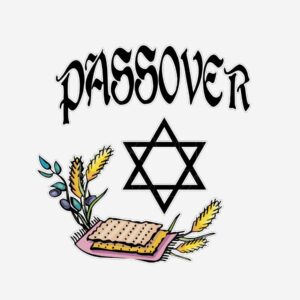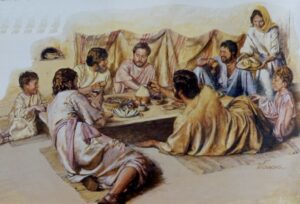A Gospel Contradiction of the Resurrection?
Cited by critics and skeptics is a seeming contradiction between the Matthew and John Gospel Resurrection accounts of Jesus of Nazareth thereby serving as proof that the Gospels lack integrity.[1] At first glance, a contradiction indeed appears to exist, but is there really one?
MT 28:8 “So they left the tomb quickly with fear and great joy, and ran to tell his disciples. Suddenly Jesus met them and said, “Greetings!”
JN 20:15-16 “Jesus said to her, “Woman, why are you weeping? Whom are you looking for?” Supposing him to be the gardener, she said to him, “Sir, if you have carried him away, tell me where you have laid him, and I will take him away. Jesus said to her, “Mary!” She turned and said to him in Hebrew, “Rabbouni!” (which means Teacher). ” (NRSV)
Matthew reports “they” (women of Galilee) were interrupted at some point with a Resurrection appearance by Jesus while on their way to inform the Disciples of the empty tomb. John’s account details the lone Mary Magdalene Resurrection encounter with Jesus at the tomb.
Gospel of John is an eyewitness account, although he refers to Mary’s witness statement in this instance, while Luke’s Gospel account is written from the perspective of an investigative reporter with one of his main sources being Peter. Luke did not include Mary’s personal witness account nor John’s involvement yet it is still consistent on the details.
Named in Matthew’s account are two women present during the angelic incident at the tomb, Mary Magdalene and the other Mary. Mark and Luke together also identify Joanna, Mary the mother of James, Salome and others, presumably women of Galilee, totaling at least 5 women.
Whether Mary Magdalene was with the women at the Resurrection encounter in Matthew’s account, it is not clear. Based on the preceding verses, it is quite possible Mary Magdalene was with the women when Jesus appeared, but the narrative does not say – either way, it cannot be assumed.
Leading up to the lone Resurrection encounter with Mary Magdalene, John states at least some of the women, including Mary Magdalene, ran to the location of Disciples Peter and John to report the empty tomb. The two Disciples then ran to the tomb to see for themselves.
John describes he and Peter running to the tomb; inspecting the empty tomb; seeing the burial clothes and marveling at what they had witnessed. Peter and John then returned to the city leaving Mary Magdalene behind, weeping.
Luke differs from John’s account mentioning only Peter ran back to see the empty tomb. Had all the Disciples been present at the location where Mary made her exclamation, logic dictates they all would have gone to see the empty tomb.
It is not surprising the other women of Galilee accompanying Mary Magdalene at the house with John and Peter did not return to the tomb – they had already been there; it was a traumatizing experience; they knew the tomb would be empty plus the admonition from the angels to go tell the other Disciples. This oft over-looked detail provides a clue…where were they?
Literary assessment of the Greek text could offer another clue. Words kai idou begin the sentence of Matthew 28:9.
A conjunction, kai is interpreted the same in almost all English Bible translations. Appearing over 9000 times in the New Testament Greek texts, about 98% translate kai as “and.”[2]
Second is idou, appearing about 200 times in the New Testament Greek texts where over 90% of 32 translations use English words of exclamation that do not denote a specific point of occurrence, such as “Behold,” “Look,” “Suddenly,” or “lo.” Barely more than just 6% use a word that indicates a specific point in time, such as “here” or “now.”[3]
Using the most common English translations of kai idou in Matthew 28:9, the verse could begin with something like, “And look” or “And behold.” The timing of this encounter with the resurrected Jesus is not time-specific leaving much of the day on Sunday when the other Disciples could have been informed by the women of Galilee.
Understandably excited in John’s account, Mary Magdalene wanted to hug Jesus, but he would not allow it because he had not presented himself to his Father, God. In Matthew’s account, the women from the tomb were allowed to hug the feet of Jesus.
MT 28:9 “But Jesus met them, saying, “Greetings!” They came to him, held on to his feet and worshiped him.”
JN 20:15-16 “Jesus replied, “Do not touch me, for I have not yet ascended to my Father. Go to my brothers and tell them, ‘I am ascending to my Father and your Father, to my God and your God.’” (NET)
NET version uses a form of “touch” and the King James Bible reads “touch me not;” however, these two translations are in the minority. John says Jesus’ response to Mary Magdalene in Greek was not to haptou or haptomai him.
Definition of the word haptomai is: “properly to attach oneself to, that is, to touch (in many implied relations).”[4] The actual Greek text in English reads, “Says to her Jesus Not Me touch not yet for have I ascended to the Father.”
A big clue, this detail in John actually corroborates the incident described in Matthew’s account. It all hinges on interpretation of the word Greek word haptomai.[5]
Once again, literary analysis of the Greek texts can clarify the issue where translation nuances can make a big difference in deciphering the true meaning. At least 32 various instances of haptomai appear in the Greek texts of the four Gospels.
“Touch” or “touched” i.e. haptomai appears in approximately 28% of the instances. Other English Bible translations use words implying that touching has already occurred, such as “hold” and “cling.”
An actual eyewitness statement is always of great value and there is one – Cleopas‘ statement quoted in Luke’s Gospel account. Heading back home, Cleopas and his partner were unwittingly joined along the way by the resurrected Jesus.
Cleopas stated, “Some of those who were with us went to the tomb and found it just exactly as the women also had said; but Him they did not see.” John’s Gospel is corroborated by the statement of Cleopas on key details: women reported their experience at the tomb; the tomb was empty; and only “some” went to verify the empty tomb.
Is there actually a Gospel Resurrection conflict or were there two different incidents described by the Gospels of Matthew and John?
Updated February 24, 2025.
This work is licensed under a Creative Commons Attribution-NonCommercial-NoDerivatives 4.0 International License.
REFERENCES:
[1] Cline, Austin. “Jesus: Contradictions in Resurrection and Ascension.” Learn Religions. 2019. <https://www.learnreligions.com/jesus-resurrection-and-ascension-contradictions-250145> Lowder, Jeffery Jay. “The Historicity of Jesus’ Resurrection The Debate between Christians and Skeptics.” TheSecularWeb. Chapter 4. 1995. <https://infidels.org/library/modern/jeff_lowder/jesus_resurrection/chap4.html> Seidensticker, Bob. “Contradictions in the Resurrection Account.” Patheos.com. 2012. <https://www.patheos.com/blogs/crossexamined/2012/04/contradictions-in-the-resurrection-account-2> Heuvel, Curt van den. “The Resurrection of Jesus Christ.” 2Think.org. 1997. <http://www.2think.org/hundredsheep/bible/ressur.shtml> Agard, Margaret. In His Footsteps. “The Tomb Is Only Empty Because Christ is Risen.” image. 2013. <https://inhisfootsteps.com/wp-content/uploads/jesus_christ_empty_tomb_goshen_utah.jpeg>
[2] “kai.” Netbible.org. Matthew 28:9. kai <2532>. 2020. Matthew 28:9. Footnote 1. NetBible.org. 2020. “kai.” BibleHub.com. Strong’s Greek 2532. 2011. “kai <2532>.” NetBible.org. 2020. ;
[3] “idou.” NetBible.org. 2020. <http://classic.net.bible.org/strong.php?id=2400> Matthew 28:9, Footnote 1. NetBible.org. 2020. <http://classic.net.bible.org/verse.php?book=Mat&chapter=28&verse=9#> “2400. idou.” BibleHub.com. 2020. <https://biblehub.com/greek/2400.htm> “idou.” BibleHub.com. Strong’s Greek 2400. 2020. <https://biblehub.com/parallel/matthew/28-9.htm> Matthew 28:9. Bi-bleHub.com. Interlinear. 2020. <https://biblehub.com/interlinear/matthew/28-9.htm> Matthew 28:9. BibleHub.com. Lexicon. 2020. <https://biblehub.com/lexicon/matthew/28-9.htm> Matthew 28:9. BibleHub.com. 2020. <https://biblehub.com/matthew/28-9.htm> Matthew 28:9. NetBi-ble.org. 2020. <http://classic.net.bible.org/verse.php?book=Mat&chapter=28&verse=9> ]
[4] John 20:17. BibleHub.com. Interlinear. 2025. <https://biblehub.com/interlinear/john/20-17.htm> “G0680” Lexicon-Concordance Online Bible. Thayer’s (New Testament Greek-English Lexicon) n.d. <http://lexiconcordance.com/greek/0680.html>
[5] “haptomai.” NetBble.net. 2020. <http://classic.net.bible.org/strong.php?id=680> “ἁψάμενος.” BibleHub.com. 2020. <https://biblehub.com/greek/apsamenos_680.htm> “ἅπτου.” BibleHub.com. 2020. <https://biblehub.com/greek/haptou_680.htm> John 20:l7. BibleHub.com. Parallel. <https://biblehub.com/john/20-17.htm> John 20:17. NetBible.org. <http://classic.net.bible.org/verse.php?book=Joh&chapter=20&verse=17>

 Interwoven throughout the Gospels are 21 references to the Passover by name and 6 references to either “the feast” or “the festival.” Skeptics make the charge that the Gospels contain Passover observance
Interwoven throughout the Gospels are 21 references to the Passover by name and 6 references to either “the feast” or “the festival.” Skeptics make the charge that the Gospels contain Passover observance 